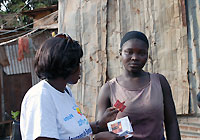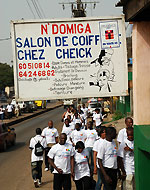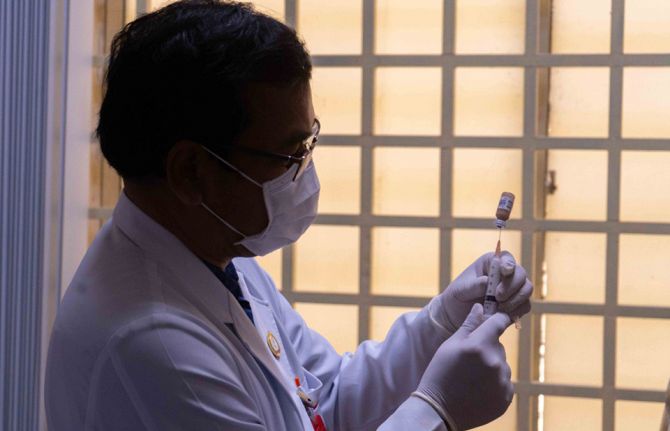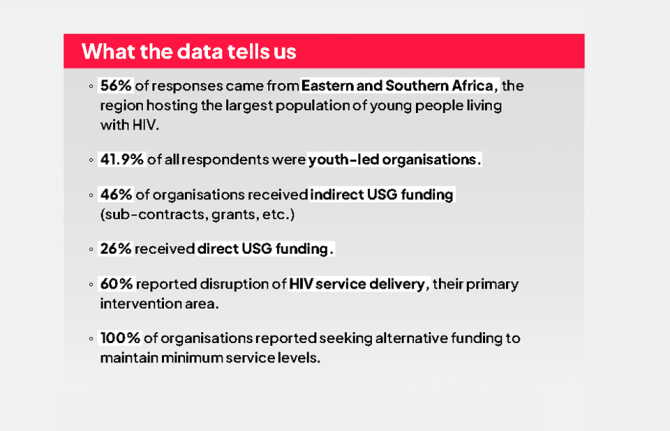
Feature Story
UNICEF working to teach AIDS prevention to young people in Guinea
16 April 2009
16 April 2009 16 April 2009A version of this story was first published on UNICEF.org

Fatoumata in a salon in a poor Koloma neighbourhood of Conakry. She is 18, has two children, aged six and three, and has never heard of AIDS. Credit: UNICEF Guinea/2009/Baro
Nene Gallé Barry sells charcoal in a very poor area of the Koloma quarter in Conakry, Guinea’s capital. She is 18 now, but left her home village four years ago to earn a living in the city. She has a boyfriend and is sexually active and, until recently, she had never heard of AIDS and had never seen or used a condom.
This is the reality for many adolescents in Guinea. Adolescents often lack access to information that will protect them from sexually transmitted infections (STIs), including HIV. According to a recent UNAIDS/WHO/UNICEF report, in 2007 only 12% of females aged 15 to 24 had correct knowledge of, and rejected myths about, sexual transmission of the virus. In addition, just under a quarter of adolescents aged 15 to 17 used condoms during sexual intercourse, according to a 2005 study.
When Nene finally learned about the risks she had been taking by not using protection, she asked for condoms. She wanted to know how to use them and how to convince her partner to wear them and was very pleased when she’d learned what to do.
Improving youth access to information
In Guinea girls are particularly at risk of contracting STIs. According to the UNAIDS/WHO/UNICEF 2008 report, 31% of girls have had sexual intercourse before the age of 15. (For boys, the figure is 20%). The publication also confirms that girls and women in the 15 to 24 age group are twice more likely to be infected with HIV than their male counterparts.

A group of peer educators enter
a hair salon in Miniere, Conakry.
Credit: UNICEF
Guinea/2009/Baro
A high number of young women are involved in jobs that expose them to unsafe sexual practices; jobs such as selling fruit on the streets or working in hair and sewing salons. In these settings they often meet male adolescents or older men who offer money in exchange for sex.
UNICEF and its national partners have taken major steps to improve youth access to information and informed decision making concerning HIV. The first national prevention strategy for youth was produced in 2007, and a coordinating team has been set up in order to coordinate and scale up activities. For the past two years UNICEF has partnered with JCI (Junior Chamber International) to empower adolescents within poor communities and involve them in projects that reach other vulnerable adolescents, mostly girls.
'My job, my health'
From 2007 to 2008 the programme reached more than 20,000 adolescents ranging in age from 13 to 20, all from different backgrounds. Eight TV spots in four different languages were produced, as well as 20 interactive radio shows.
The newest project is called 'mon MÉtier, ma santé' ('my job, my health'), and aims to reach girls working in hair dressing and tailoring shops in two of the poorest neighbourhoods in Conakry. One hundred peer educators are planning to visit the selected sites and help educate young apprentices and clients about HIV prevention.
It is hoped that once the young girls have received the information about HIV prevention will then reach out to their family members and friends. A study will be conducted after two months of such sensitization activities to evaluate the impact of the project. UNICEF hopes to be able to reach at least 50 per cent of the most vulnerable girls by 2011.
Right Hand Content
Key populations:
Young people
Women and girls
Condoms
HIV prevention
Cosponsors:
Partners:
Junior Chamber International (JCI)
Feature stories:
Barber Shops and Beauty Salons promote HIV education in Guyana (26 March 2009)
Condoms and HIV prevention: Position statement by UNAIDS, UNFPA and WHO (19 March 2009)
Costa Rica: Peer HIV prevention programmes to be promoted for young people (03 March 2009)
Publications:
Best practice: Making condoms work for HIV prevention (pdf, 1.1 Mb)
UNAIDS action plan on intensifying HIV prevention (pdf, 1.71 Mb)



